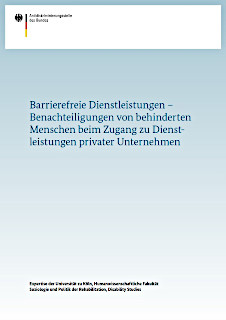Barrier-free services
Discrimination of people with disabilities in access to services from private enterprises
- Factsheet on the research project -
Authors: Anne Waldschmidt, Arne Müller, published by the Federal Anti-Discrimination Agency (FADA) Year of publication: 2013
Brief overview
The aim of this expert opinion commissioned by FADA is to determine in which daily activities people with disabilities are discriminated against and what form this discrimination takes. For the purpose of the study, an evaluation was made of interviews with experts as well as 280 documented counselling cases, from 2006 to 2011, submitted by the counselling centres and counselling points. In addition, the expert opinion contains an analysis of existing scientific literature.
Main results
In the majority of the cases submitted for evaluation by FADA, it was possible to identify typical patterns and forms of discrimination against persons with disabilities with respect to the accessibility of goods and services.
Forms of discrimination
The typical forms of discrimination found consisted of:
- refusal of services or access (for example to restaurants and similar establishments),
- problems with barrier freedom,
- discrimination and harassment, for example in the form of verbal abuse, insults, stigmatisation and refusal of recognition,
- refusal of compensation for disadvantage.
In the evaluated counselling cases, these forms sometimes appeared in combination or even simultaneously.
Typical discrimination patterns
It was possible to identify seven key areas in which persons with disabilities face disadvantages in everyday situations:
- In 33 percent of the cases examined, discrimination was present in the area of financial services; that is, insurance, banking and postal services. In the majority of cases, insurance coverage was refused.
- 20 percent of the cases examined delt with discrimination in the area of transport and mobility. The problem here was predominantly one of barrier freedom, for example, with Deutsche Bahn (German Rail), going on trips, travelling by plane and on public transport.
- 18 percent of the cases occur in the area of recreation and culture, that is: at cultural and sports events, in recreational parks, cinemas and restaurants. A broad spectrum of discrimination could be observed at these locations. They ranged from denial of service, problems with barrier freedom and denial of entry to harassment.
- Some 15 percent of the cases fell into the category of housing. Typically, the discrimination was related to rentals but there were also incidents of discrimination from neighbours.
- Discrimination in the area of health services and in retail commerce accounted for four percent respectively of the cases examined and for three percent respectively in the areas of media and communications.
Justifications in one-third of cases
In more than one-third of the cases (32.5 percent), objective justification was found pursuant to the General Equal Treatment Act. This was strongly criticised by the victims themselves and the General Equal Treatment Act considered unjust by them in this respect.
Situation of persons under legal guardianship
In the cases examined, only about 1.8 percent of the complaints came from persons under legal guardianship pursuant to Section 1896 of the Civil Code (BGB). Persons affected by legal guardianship are adults who, as a result of mental disease or physical, mental or psychological disability, are partially or totally incapable of managing their own affairs. This group experienced exclusion from financial services, in particular. Within the framework of the expert interviews, it was also surmised that guardianship relationships are fundamentally characterised by considerable ignorance and fear.
Definition of terms
- Buildings, transport and communications vehicles for example are considered to be ‘barrier-free’ if they are accessible and usable for persons with disabilities in the normal manner without particular difficulty and without the need for help from others.
- Compensations for disadvantage are benefits and measures to compensate persons with disabilities for discrimination experienced and additional expenses. Compensations for disadvantage are for example: free travel for an attendant or reduced entry fees.
Options for action
- Enterprises should educate their employees on the equality rights of people with disabilities and how to deal with these clients.
- With respect to discrimination in the area of financial services, a package of measures that should be taken would start with a round-table of all of those affected and include the development of further training offers, education and awareness building through public relations work and support for test cases brought before the courts by affected persons.
- In order to facilitate future evaluations, counselling centres and counselling points should document counselling cases in line with the categories proposed in the expert opinion. Furthermore, counselling centres need to be equipped with sufficient and reliable financial resources.
- More empirical, comparative and interdisciplinary research is needed on the discrimination of persons with disabilities in every-day life, on multiple discrimination, as well as on discrimination of persons under legal guardianship pursuant to Section 1896 of the Civil Code.

